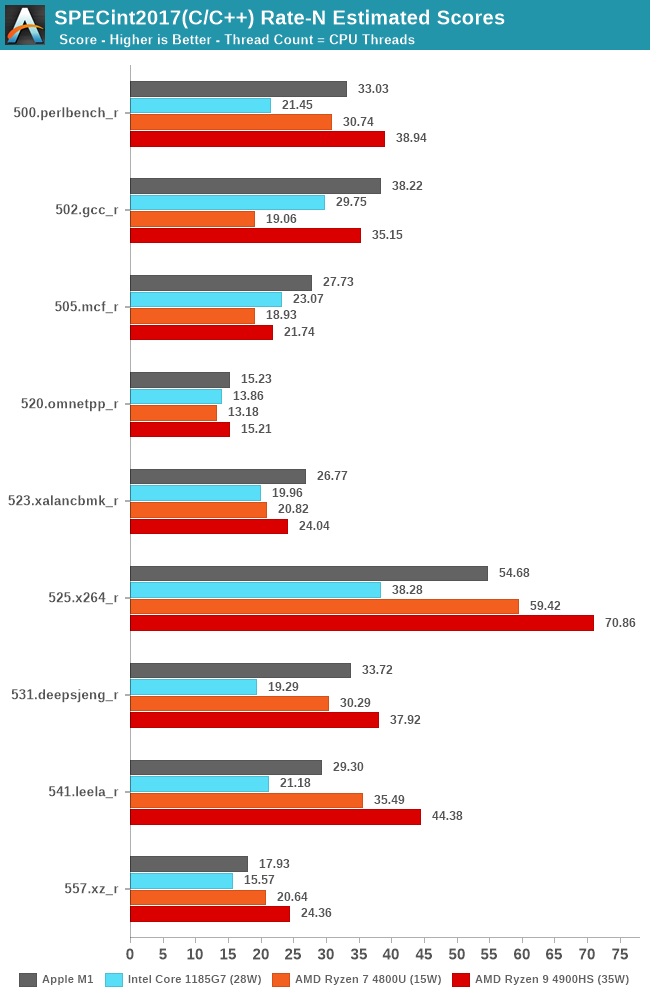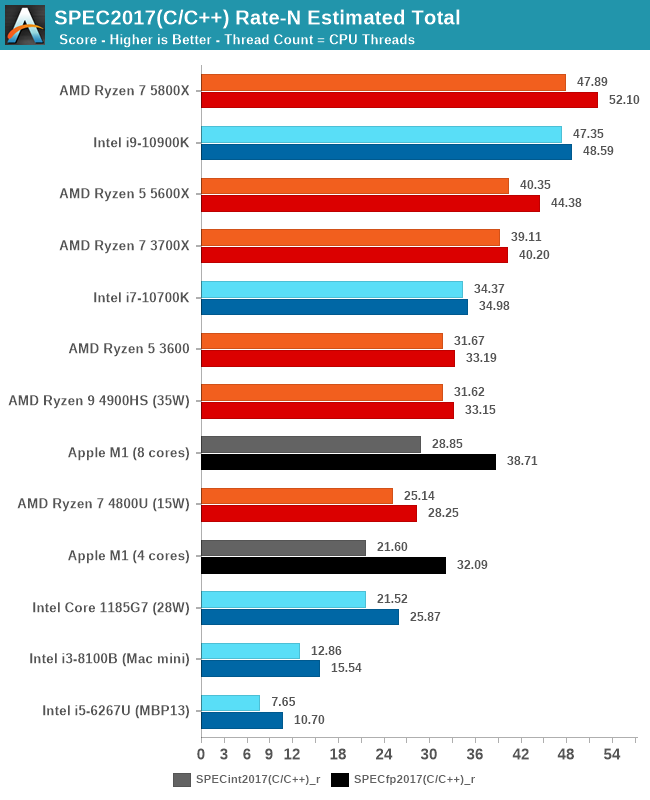The 2020 Mac Mini Unleashed: Putting Apple Silicon M1 To The Test
by Andrei Frumusanu on November 17, 2020 9:00 AM ESTSPEC2017 - Multi-Core Performance
While we knew that the Apple M1 would do extremely well in single-threaded performance, the design’s strengths are also in its power-efficiency which should directly translate to exceptionally good multi-threaded performance in power limited designs. We noted that although Apple doesn’t really publish any TDP figure, we estimate that the M1 here in the Mac mini behaves like a 20-24W TDP chip.
We’re including Intel’s newest Tiger Lake system with an i7-1185G7 at 28W, an AMD Ryzen 7 4800U at 15W, and a Ryzen 9 4900HS at 35W as comparison points. It’s to be noted that the actual power consumption of these devices should exceed that of their advertised TDPs, as it doesn’t account for DRAM or VRMs.

In SPECint2017 rate, the Apple M1 battles with AMD’s chipsets, with the results differing depending on the workload, sometimes winning, sometimes losing.

In the fp2017 rate results, we see similar results, with the Apple M1 battling it out with AMD’s higher-end laptop chip, able to beat the lower TDP part and clearly stay ahead of Intel’s design.

In the overall multi-core scores, the Apple M1 is extremely impressive. On integer workloads, it still seems that AMD’s more recent Renoir-based designs beat the M1 in performance, but only in the integer workloads and at a notably higher TDP and power consumption.
Apple’s lead against Intel’s Tiger Lake SoC at 28W here is indisputable, and shows the reason as to why Apple chose to abandon their long-term silicon partner of 15 years. The M1 not only beats the best Intel has to offer in this market-segment, but does so at less power.
I also included multi-threaded scores of the M1 when ignoring the 4 efficiency cores of the system. Here although it’s an “8-core” design, the heterogeneous nature of the CPUs means that performance is lop-sided towards the big cores. That doesn’t mean that the efficiency cores are absolutely weak: Using them still increases total throughput by 20-33%, depending on the workload, favouring compute-heavy tasks.
Overall, Apple doesn’t just deliver a viable silicon alternative to AMD and Intel, but actually something that’s well outperforms them both in absolute performance as well as power efficiency. Naturally, in higher power-level, higher-core count systems, the M1 can’t keep up to AMD and Intel designs, but that’s something Apple likely will want to address with subsequent designs in that category over the next 2 years.










682 Comments
View All Comments
Rrrumble - Tuesday, January 25, 2022 - link
You may have missed the part where apple started the "business" (the smart phone, with the iPod as a first step) and grew and expanded it with savvy products and marketing while others tried catch up.Henry 3 Dogg - Friday, November 27, 2020 - link
"...Apple have tonnes of free cash that they could use to buy something they don't really need that makes money, but they don't do it. Instead they buy back their own stock. ..."Not true. Yes, Apple does buy back their own stock but they also have a subsidiary called Braeburn Capital which is sitting on around $250 Billion worth of investments.
theonetruestripes - Tuesday, December 1, 2020 - link
Apple _likes_ focus. When I worked there SJ made the point that Apple had incredible brand loyalty, but making some products that "make money" but are not as good as the rest of the products damages that brand loyalty. That seems pretty obvious to me at the time. Th other point he made is projects cost attention. If Apple launched a line of drink bottles it would take his time, designers time, marketing time, and many others. Some of that you can "just hire" if you have enough money, but you can't "just hire" more hours into the CEO's day, or SVP's days.To a certain extent that might not matter for something as distant from Apple's core business as say owning a CPU design firm. If Apple bought ARM and the ARM reference designs are "meh" very few people will decide that means the new MacBook Pro is "meh" by association. However it would still require some CEO time to decide "this new ARM subsidiary can't be called anything Apple related, and needs to make sure nobody is allowed to buy products from them and claim they are Apple related - we absolutely don't want a new "Apple Powered Dell" marketing campaign anywhere!"; how much money is that time worth? I'm sure there is some number at which you could say "if buying ARM makes this much per year it is worth 300 hours of Tim's time to close the deal and 16 hours per Q to make sure it doesn't screw anything up", but it may be a much higher number then ARM actually generates.
(or it might not, I expect a large part of Apple not being excited about buying ARM is lack of likelihood of getting regulatory approval, likelihood of needing to appear before congress to defend the purchase if in fact it is approved, and lack of any meaningful value to Apple (i.e. Apple has all the ARM license it needs to do anything it decides to))
alysdexia - Monday, December 28, 2020 - link
cares !-> they; 1 != 2; and you liardysonlu - Sunday, February 21, 2021 - link
If Apple buys Arm, not only does it have to keep licensing out Arm's designs but it may risk being forced to license its own CPU design/innovation as well since with Apple+Arm being a single entity, there is no longer any distinction in CPU intellectual properties between the two companies.Henry 3 Dogg - Friday, November 27, 2020 - link
Apple owned 43% of ARM for several years. There are more reasons than licensing technology to buy a all or part of a company.There are some very good reasons why Apple might choose to own 20% of ARM.
danbob999 - Tuesday, November 17, 2020 - link
Actually it's the opposite. It's the cheapeast/narrowest license from ARM. More expensive license include access to full Cortex cores, and not only instruction set.Spiderman10 - Tuesday, November 17, 2020 - link
No helios24 is correct. The Arch. license is at the top of the licensing pyramid. Anandtech actually wrote a piece about this here: https://www.anandtech.com/show/7112/the-arm-diarie...ws3 - Tuesday, November 17, 2020 - link
Danbob is confused by the fact that Apple doesn't use the ARM designs. He assumes that lack of use results from lack of access.RedGreenBlue - Tuesday, November 17, 2020 - link
They still based some designs closely to the generic ones. I think the A7 was shown to be only slightly modified in Anandtech’s review (the first 64-bit with Arm-v8(?))